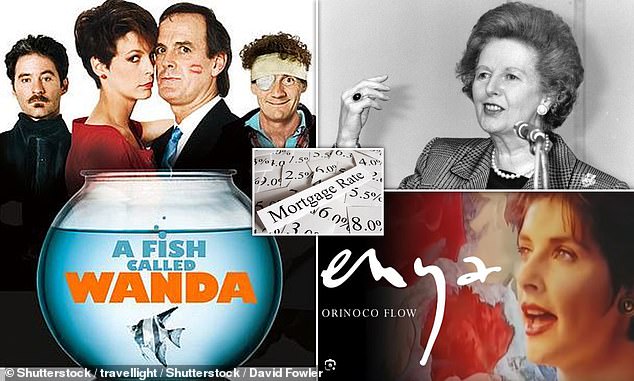When it comes to famous anniversaries, the introduction of the fixed rate mortgage is unlikely to be one that most people are keeping tabs on.
But Britons have adopted them in their droves since the first fixed rate mortgage was introduced 35 years ago, and since then, and they are now the product of choice for the majority of homeowners.
Halifax Building Society, as it was then, launched the first UK fixed rate mortgage in November 1988.

One to recollect: Halifax Building Society, as it was then, launched the first UK fixed rate mortgage in November 1988
Around that same time, the film, A Fish Called Wanda, was released, the cult song Orinoco Flow by Enya hit number one in the UK charts and Margaret Thatacher officially became the longest serving prime minister of the 20th century – the longest serving PM since William Gladstone
With the help of Andrew Hagger at MoneyComms, we take a look at how the mortgage and property landscape has changed since then.
There are now a total of 8.8million residential mortgages outstanding, according to UK Finance, the bulk of which (82 per cent) are on fixed-rate deals.
Hagger, a personal finance expert and founder of MoneyComms says: ‘Over the last three and a half decades, fixed rate mortgages have revolutionised the residential borrowing market.
‘They have been fundamental to many consumers who sought the financial certainty and stability that this breed of mortgage product provides.
‘In 1996 only one in five mortgages were on a fixed rate; by 2010, half of mortgages were fixed; and in recent years at least nine out of 10 new mortgages have been fixed.
‘The mortgage market is unrecognisable from thirty-five years ago, it is now far more competitive and dynamic.’

Ups and downs: The interest rate on the UK’s first fixed rate mortgage was 12.75%. Fast forward 35 years to today and the average rate for a two-year fix is 5.63%
Property is less affordable than in 1988
Many people argue that the combination of high mortgage rates and high house prices means homeownership is now more unaffordable than ever.
However, others often counter this view by pointing out that today’s mortgage rates are nothing compared to the double-digit rates of the 1980s, for example.
So which is right?
The interest rate on the UK’s first fixed rate mortgage was 12.75 per cent and the average UK property price stood at £55,448, according to HM Land Registry data.
Fast forward 35 years and the average rate for a two-year fix, according to the Bank of England, is 5.63 per cent, while the average property price is more than five times 1988 levels at £291,044.
> Work out how much you could afford to borrow with our mortgage calculator tool

Is it more or less affordable now? Mortgage rates might be a lot lower now than they were in 1988, but house prices are more than five times more expensive
The research found that in November 1988 the monthly mortgage repayment for someone borrowing 75 per cent of the average house price was £461 and accounted for 44 per cent of the average gross salary.
Even though house prices have increased year-on-year, historically low fixed mortgage rates kept average mortgage costs below 30 per cent of the average salary through the whole decade between 2010 and 2020.
However, today a 75 per cent loan-to-value mortgage on the average-priced home would account for a record 51.3 per cent of the average gross salary thanks to soaring mortgage rates in 2022 and 2023.
This sudden spike in interest rates since late 2022 has seen the annual mortgage cost as a percentage of gross salary rocket from 30.9 per cent in November 2021 to 51.3 per cent 12 months later.

Andrew Hagger, personal finance expert and founder of MoneyComms says the mortgage market is unrecognisable from 35 years ago, it is now far more competitive and dynamic
Back in 1988, a mortgage covering 75 per cent of the typical property’s value would have amounted to £41,586. At a rate of 12.75 per cent, this would have equated to paying £461 per month, if being repaid over a 25-year term.
Today, a mortgage covering 75 per cent of an average property’s value would amount to £218,355. If the average rate was still 12.75 per cent, this would compare to £2,421 per month.
However, with the average rate currently at 5.63 per cent for a 2-year fixed rate, monthly repayments are currently £1,358, according to MoneyComms’ analysis.
Since 1988 the average property price has increased more than fivefold (5.2x), but current interest rates mean monthly average mortgage repayments are fractionally below three times higher (2.95x).
Shift towards longer mortgage terms
In recent decades there has been a clear trend of Britons borrowing for longer.
This is typically achieved by lengthening the term of a mortgage. This is the number of years someone agrees to repay their mortgage for.
By choosing a longer term, buyers can reduce the amount of their monthly payments – but as interest continues to accrue for longer, they will pay more overall.
The average term of first time buyers’ mortgages has steadily been increasing over the years. In 2005, the average term was 25 years. Today, it is 31 years.
According to UK Finance, by the end of last year, well over half of first-time buyers and one third of home movers were borrowing over terms in excess of 30 years.

Popular: The first fixed rate mortgage was introduced 35 years ago, and since then, they’ve become the product of choice for the majority of British homeowners and homebuyers
Andrew Hagger adds: ‘This is fine if it’s just a temporary means of affording the monthly payments for a short term before remortgaging, but if you see the 30 plus year term through to the end, the additional costs are quite eye watering.
‘If someone were to take out a £218,355 mortgage at the current average rate of 5.63 per cent it would cost £407,459 over 25 years but £500,474 over a 35-year term – an extra £93,015 – even on a more conservative mortgage rate of 4 per cent the difference would be £60,221.’
> Should I extend the term of my mortgage to lower the monthly payments?
What’s next for mortgage borrowers?
Sharp mortgage rate increases are now resulting in extreme payment shocks when people come to renew their fixed rate deals.
Two years ago, the average two-year fixed rate was just shy of 2 per cent, and anybody now rolling off an old deal is likely to be in for a shock when their mortgage payments suddenly skyrocket.
Now the average two-year fixed-rate is more than 5.5 per cent and standard variable rates are as high as 9.49 per cent.
With a advance 1.6 million fixed rate deals ending in 2024, according to UK Finance, it means more than 4.4 million borrowers will have suffered a rate shock since the series of base rate hikes commenced in December 2021.

Payment shock: The sharp mortgage rate increases are now resulting in extreme payment shock scenarios when people come to renew their fixed rate deals
Alastair Douglas, chief executive of credit data firm TotallyMoney, says: ‘For 13 years, the Bank of England kept the base rate locked below 1 per cent, and the thought of it suddenly ramping up to 5.25 per cent was almost unimaginable.
‘People became used to cheap money — and rock bottom rates helped drive up property prices.
‘And while rates were higher and wages lower, 35 years ago, homes were much cheaper.
‘Mortgage costs now make up a considerably larger percentage of somebody’s earnings, and two years of rampant inflation will have advance compounded their struggles to keep up.
‘When applying for any credit product – and especially when it’s for such a large amount – it’s essential to really do your research and to consider a range of options.
‘An independent broker could help, but also bear in mind that both your circumstances and the world around you can change at any moment.’
Some links in this article may be affiliate links. If you click on them we may earn a small commission. That helps us fund This Is Money, and keep it free to use. We do not write articles to encourage products. We do not allow any commercial relationship to affect our editorial independence.




